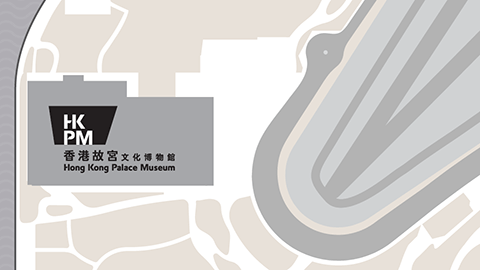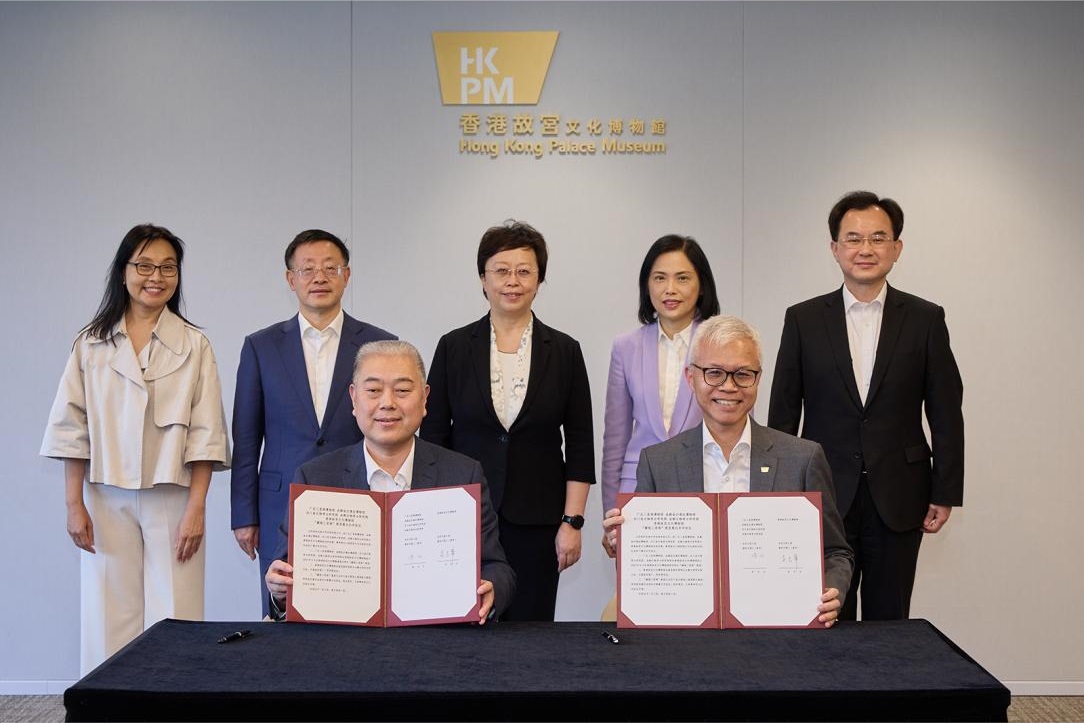Showcasing 120 treasures, including the latest archaeological discoveries unearthed at Sanxingdui, presented for the first time outside Sichuan
The Hong Kong Palace Museum (HKPM) is delighted to announce the signing of a letter of intent on collaboration with the Sanxingdui Museum in Guanghan, the Jinsha Site Museum in Chengdu, the Sichuan Provincial Institute of Cultural Relics and Archaeology, and the Chengdu Cultural Relics and Archaeology Research Institute to jointly organise the special exhibition “Gazing at Sanxingdui: New Archaeological Discoveries in Sichuan” (“Gazing at Sanxingdui”) at the HKPM. The exhibition, to be launched during the 2023 National Day holidays, aims to advance cultural exchange between Hong Kong and Sichuan Province and promote the best of Chinese traditional culture. Bank of China (Hong Kong) Limited will be the Sole Sponsor of the special exhibition, which will last about four months.
The letter of intent on collaboration was signed by Tang Fei, Director of the Sichuan Provincial Institute of Cultural Relics and Archaeology representing the Sanxingdui Museum in Guanghan, Jinsha Site Museum in Chengdu, Sichuan Provincial Institute of Cultural Relics and Archaeology, and Chengdu Cultural Relics and Archaeology Research Institute, and Dr Louis Ng, Museum Director of the HKPM. The signing was witnessed by Zheng Li, member of the Standing Committee and Director of the Publicity Department of the CPC Sichuan Provincial Committee; Dai Yunkang, Director of the Sichuan Provincial Department of Culture and Tourism; Betty Fung, Chief Executive Officer of the West Kowloon Cultural District Authority (WKCDA); and Wendy Gan, Deputy Chief Executive Officer (District Development) of WKCDA. Under the agreement, the HKPM, the Sanxingdui Museum in Guanghan, and the Jinsha Site Museum in Chengdu will jointly organise the special exhibition “Gazing at Sanxingdui: New Archaeological Discoveries in Sichuan” in late September 2023. The exhibition is supported by the Sichuan Provincial Institute of Cultural Relics and Archaeology and the Chengdu Cultural Relics and Archaeology Research Institute.
“Gazing at Sanxingdui” focuses on the new archaeological discoveries at Sanxingdui in Sichuan Province, featuring 120 pieces of precious bronze, jade, gold, and pottery dated to 2,600–3,300 years ago. Nearly half of the relics to be displayed at the special exhibition were unearthed in the most recent excavations at the Sanxingdui archaeological site between 2020 and 2022, and the majority of them will be exhibited outside Sichuan for the first time. Highlighted exhibits include various types of bronze masks, bronze statues, and gold masks that can be traced back to 3,000–3,200 years ago, as well as precious objects from the Jinsha Site Museum, such as the jade yue-axe, dating back over 3,000 years, which will be exhibited outside Sichuan for the first time.
The excavations at Sanxingdui form one of the key initiatives of “Archaeological China”, which was launched by the National Cultural Heritage Administration. The discoveries shed new light on the highly developed Bronze Age civilisation in the upper Yangtze River region and exchanges between ancient Sichuan and its surrounding regions, revealing the origin and early development of Chinese civilisation as well as its “diversity in unity” developmental pattern.
Tang Fei, Director of the Sichuan Provincial Institute of Cultural Relics and Archaeology remarked, “The precious cultural relics unearthed from the Sanxingdui and Jinsha sites represent the splendour of the ancient Shu material and spiritual civilisation, which was co-created by various ethnic groups in the ancient Shu state and the Shu region. It has formed a core part of Chinese civilisation, reflecting the remarkable achievements of the civilisation developed in the upper Yangtze River region before the Qin dynasty (221–206 BCE). The close connections between the ancient Shu civilisation, the Yellow River region civilisation, and the middle and lower Yangtze River regions civilisation demonstrate the ‘diversity in unity’ configuration of Chinese civilisation, which is highly significant in the history of Chinese and world civilisations. We are looking forward with great anticipation to the presentation of these precious cultural objects at the Hong Kong Palace Museum for Hong Kong citizens as well as visitors from the Mainland and around the world. We aim to deepen visitors’ understanding of the historical value of the ancient Shu bronze civilisation, broaden the international impact of Chinese culture, and promote cultural exchange and mutual understanding among world civilisations.”
Dr Louis Ng, Museum Director of the HKPM said, “Many important relics have been unearthed during the latest excavation of the Sanxingdui site in the past three years. These discoveries have attracted great attention domestically and internationally. We are immensely grateful to Sichuan provincial museums and other cultural and archaeological institutions for lending us these precious relics from the Sanxingdui and Jinsha sites. This special exhibition reinforces the HKPM’s mission to promote the inheritance of traditional Chinese culture and deepen our Chinese and global audiences’ understanding of the lives and cultures of various regions and ethnic groups as well as exchanges among them in ancient China, which have contributed to the magnificence of China’s 5,000 years of civilisation and its ‘diversity in unity’ pattern of development.”
Sun Yu, Vice Chairman and Chief Executive of BOCHK said, “Chinese civilisation has a long and profound history and is the foundation of contemporary Chinese culture. Iconic and fascinating, Sanxingdui is the focus of the world’s attention, and BOCHK is proud to be the Sole Sponsor of this special exhibition. We believe that it will deepen Hong Kong people’s understanding of Chinese history and culture, and at the same time showcase the splendid achievements of Chinese civilisation to international audiences, supporting Hong Kong’s development as an East-meets-West centre for international cultural exchange and promoting Chinese civilisation.”
To accompany this important exhibition, the HKPM will organise a series of scholarly programmes and public learning activities on the theme of the ancient Shu civilisation to foster exchange between Hong Kong and Sichuan province in archaeological and cultural studies and underscore China’s archaeological achievements in the past century. More information about the exhibition, including ticketing arrangements, will be announced in due course.
Remarks
About the Hong Kong Palace Museum
The Hong Kong Palace Museum aspires to become a leading institution on the study and appreciation of Chinese art and culture while advancing dialogue between world civilisations. The Hong Kong Palace Museum is a collaborative project between the West Kowloon Cultural District Authority and the Palace Museum, and is funded by The Hong Kong Jockey Club Charities Trust with a donation of HK$3.5 billion for its establishment, as well as some of the annual exhibitions and education programmes in 2023–2031.
Embracing new curatorial approaches, the Museum combines a Hong Kong perspective with a global vision to present precious artefacts from the Palace Museum and other important cultural institutions around the world. Through research, exhibitions, and educational and professional exchange programmes, the Museum aims to build international partnerships and position Hong Kong as a global hub for art and culture. At heart a resource that belongs to the local community, the Museum strives to inspire community engagement, foster dialogue, and promote creativity and interdisciplinary collaboration.
About the West Kowloon Cultural District
The West Kowloon Cultural District is one of the largest and most ambitious cultural projects in the world. Its vision is to create a vibrant new cultural quarter for Hong Kong on 40 hectares of reclaimed land located alongside Victoria Harbour. With a varied mix of theatres, performance spaces, and museums, the West Kowloon Cultural District will produce and host world-class exhibitions, performances, and cultural events, providing 23 hectares of public open space, including a two-kilometre waterfront promenade.
https://www.westkowloon.hk/








